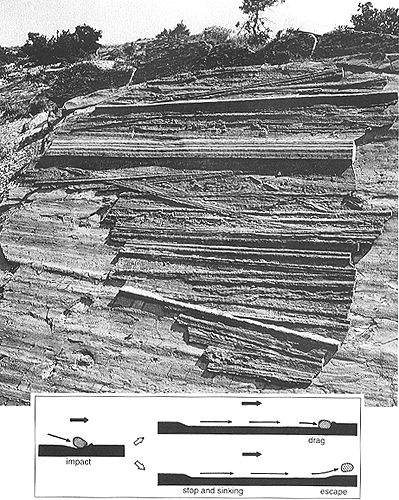
Tool marks: groove casts
Plate 98

Tool marks: groove casts
Plate 98
The term "tool mark" refers to a trace of erosion made by an object carried by the current rather than by the fluid itself. In this category, various forms are distinguished by specific names. In this plate, for example, groove casts are illustrated by a magnificent exposure in overturned turbidite beds. The sole was exhumed when a forest road was open, but rapidly deteriorated: the picture already shows the progressive detachment of sandstone slabs from the almost vertical wall, reminding of the unlucky fate of frescos abandoned to pollution.
Grooves are linear, parallel marks, of uniform relief, locally intersecting at acute angles (lower than 40°). Their surface is either smooth and rounded or striated. Sizes are extremely variable. They are produced by solid objects impacting on a mud bottom and dragged by a current for several decimeters or meters. These objects consist of mudstone fragments, shells, or waterlogged plant fragments (twigs, branches, etc.); they were present in the source area of the flows or became incorporated by intrabasinal erosion. Tools are rarely found on the bed surfaces, even where the ends of the marks are visible. This is not remarkable, however: materials like clay and vegetal matter, for example, are deteriorable and tend to disintegrate owing to friction with the bottom; those that survive can be deposited within the bed, as in the present case where clay chips occur a few centimeters above the base (see plate 99).
The fact that the objects slid on the bottom, with little or no rotation, suggests that they were too heavy to be lifted by eddies, or that turbulence was suppressed near the base of flow by a high concentration of suspended particles. Eventually, however, they were raised in the fluid, as they are not found at groove ends (see inset).
Marnoso-arenacea Formation, northern Apennines.
| Photo: G. Piacentini 1970. |